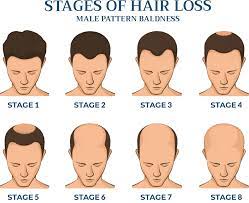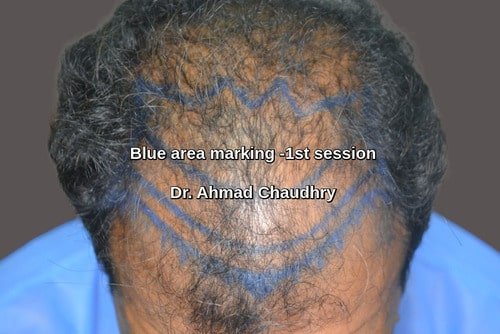Male pattern baldness is triggered by gene and sex hormone testosterone. Research suggests that a normal person can lose up to one hundred to one hundred and fifty hairs per day. Hair grows in three phases and lives for five years on the scalp. But in some cases, the lost is not replaced by a new one. This condition is known as androgenic alopecia. In these cases, hair starts losing in a well-defined pattern first affecting the temples and later on the crown or vertex. This affects the natural look of men. Initial thinning from various parts of the scalp can make a man bald within a few years. Women rarely suffer from this pattern alopecia problem. Certain genetic factors play a major role in androgenetic alopecia.
Male pattern baldness common cause
Dihydrotestosterone hormones abbreviated as DHT sometimes present in larger quantities in men, they can easily get bald. These hormones have adverse effects on follicular units which in results become weak. Hairs growth is decreased and they start shedding frequently. It is concluded after doing research that men who have a history in their family are likely to get more affected from MPB. Men younger than twenty can get affected from this problem. First, they start experiencing a significant amount of receding from their hairline. Then, they experience loss from temples and crowns. Some began to lose patches from their scalp in a specific pattern. Gradual thinning finally leads to the partial or total baldness.
Proper diagnosis from specialist
It is important to consult a dermatologist whenever someone is suffering from these symptoms. Usually they can be diagnosed due to their hair loss pattern and appearance. Sometimes there can be swelling, soreness, redness and pain on the scalp. Skin biopsy is used to diagnose severity of hair loss in some patients from an accurate result. If it is diagnosed at early stages, there are many chances that patients can restore back. Seven stages of androgenetic alopecia can also help physicians to identify the severity.
Best hair treatment for level 1 baldness
When it comes to treatment for male pattern baldness, non surgical treatments are initially recommended. They are considered to be affordable and effective. Two medicines available for treatment are also approved by FDA. One is Minoxidil (Rogaine) which helps in stimulating the growth and preventing further hair loss. Finasteride (Genesis tablet) is taken orally to normalize the production of DHT hormones. Disadvantages of these medications are that if patients stop using them, they will start shedding again.
Permanent solution for advance Androgentic alopecia
Hair transplant surgeries are the permanent treatments for those suffering from androgenetic alopecia. Some follicles are totally damaged and new can never re-grow in their place. Non surgical treatments can prohibit further hair loss, but they cannot help in hair regrowth if follicles are not present. Transplant surgeries are expensive, but they are cost effective in the long-term. In these surgeries, follicles from dense areas of the scalp are taken and inserted into the bald part of the scalp.
Frequently Asked Questions
What is the best treatment for male pattern baldness?
There are different stages among male and female patients. MPB is treated through hair transplant surgery. It is a permanent solution.
What is the cost of the treatment?
Cost depends upon the hair loss level. Normal range to treat such condition is 1000$ to 4000$
Who is the best doctor for male pattern baldness treatment?
Dr. Ahmad Chaudhry is the best doctor in Pakistan who has specialization in hair diseases and their treatments from France. He has 23 years experience in this field and treated many cases through hair restoration surgery in Pakistan successfully. To see before and after results and reviews go to the gallery section.
How to get an appointment from Dr. Ahmad Chaudhry?
To get an appointment you may contact us through call or WhatsApp
Free advice | Call or WhatsApp | +923334309999



